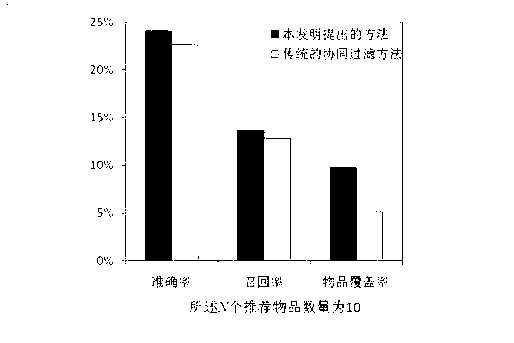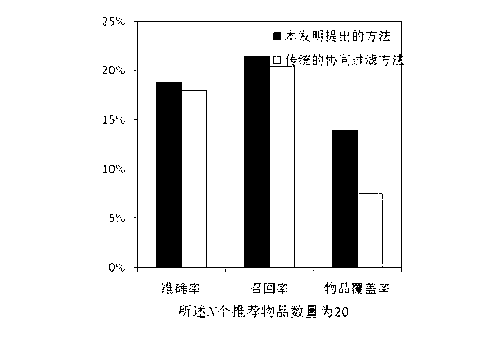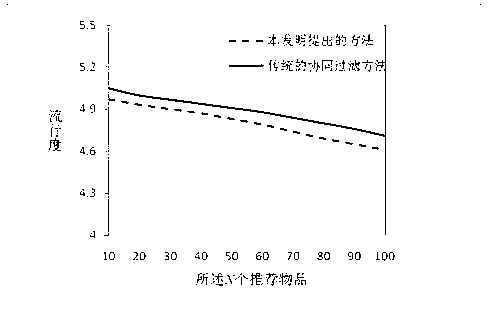Collaborative filtering method and system based on similarity propagation
A similarity transfer and collaborative filtering technology, applied in the field of collaborative filtering based on similarity transfer, can solve the problems of low similarity accuracy and recognition, and unsatisfactory recommendation success rate, so as to improve the recognition and recommendation coverage. High, avoids the effect of similarity measures
- Summary
- Abstract
- Description
- Claims
- Application Information
AI Technical Summary
Problems solved by technology
Method used
Image
Examples
Embodiment 1
[0046] In an example of the present invention, "MovieLens100K" is used as the data set, and when the number of recommended items N is 10, such as image 3 As shown, the comparison with the traditional collaborative filtering method in the recommendation accuracy, recommendation recall rate and recommended item coverage index. In the selected data set, randomly select 80% as the training set and the remaining 20% as the test set. The data set already contains the ratings of the data. Select the training set and test set with a score greater than "2" to indicate liking, and replace it with "1", otherwise use "0" instead. The method proposed in the present invention and the recommendation accuracy rate of the traditional collaborative filtering method, the recommendation recall rate and the comparison result of the coverage index of the recommended item are adopted respectively, wherein the k other users are taken as 942, that is, all other users in the system are selected, and...
Embodiment 2
[0048] In an example of the present invention, "MovieLens100K" is used as a data set, and when the number of recommended items N is 20, such as Figure 4 As shown, the comparison with the traditional collaborative filtering method in the recommendation accuracy, recommendation recall rate and recommended item coverage index. In the selected data set, randomly select 80% as the training set and the remaining 20% as the test set. The data set already contains the ratings of the data. Select the training set and test set with a score greater than "2" to indicate liking, and replace it with "1", otherwise use "0" instead. The method proposed in the present invention and the recommendation accuracy rate of the traditional collaborative filtering method, the recommendation recall rate and the comparison result of the coverage index of the recommended item are adopted respectively, wherein the k other users are taken as 942, that is, all other users in the system are selected, and ...
Embodiment 3
[0050] In an example of the present invention, "MovieLens100K" is used as the data set, and when the number of recommended items is from 10 to 100, such as Figure 5 As shown, the comparison with traditional methods in recommending low popularity items to users. In actual recommendation, it is difficult to recommend items with low popularity to customers, and recommending items with low popularity is the direction of development. In the selected data set, 80% are randomly selected as the training set, and the remaining 20% are used as the test set. The scores in the training set and the test set are greater than "2" to indicate liking, replaced by "1", otherwise replaced by "0". The comparison results of the item popularity index changing with the number of the N recommended items using the method proposed in the present invention and the traditional collaborative filtering method respectively, wherein the k other users take 942, that is, select all other users in the system...
PUM
 Login to View More
Login to View More Abstract
Description
Claims
Application Information
 Login to View More
Login to View More - R&D
- Intellectual Property
- Life Sciences
- Materials
- Tech Scout
- Unparalleled Data Quality
- Higher Quality Content
- 60% Fewer Hallucinations
Browse by: Latest US Patents, China's latest patents, Technical Efficacy Thesaurus, Application Domain, Technology Topic, Popular Technical Reports.
© 2025 PatSnap. All rights reserved.Legal|Privacy policy|Modern Slavery Act Transparency Statement|Sitemap|About US| Contact US: help@patsnap.com



